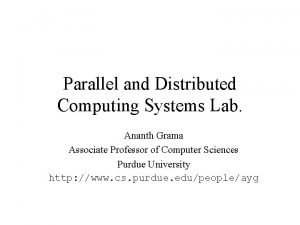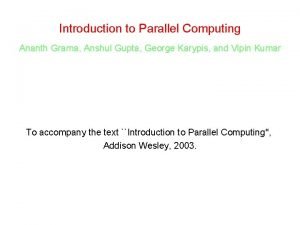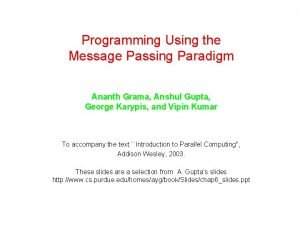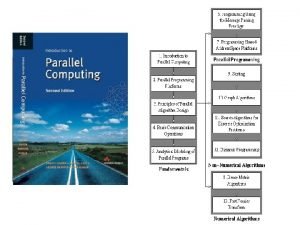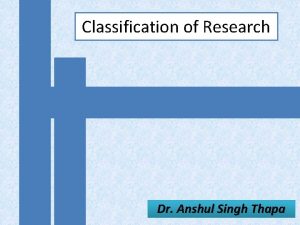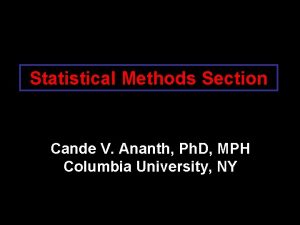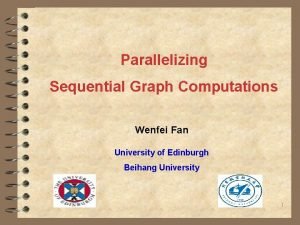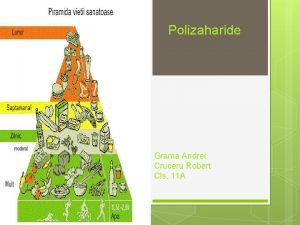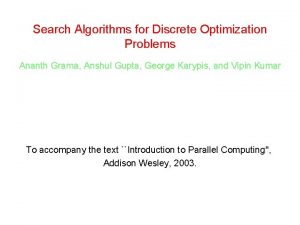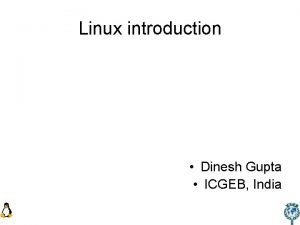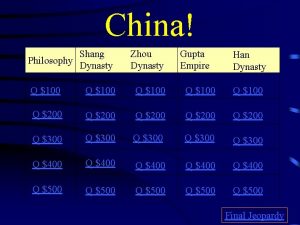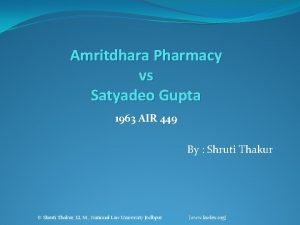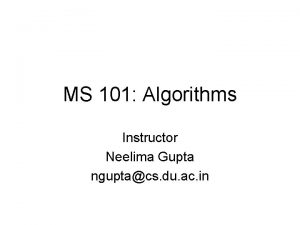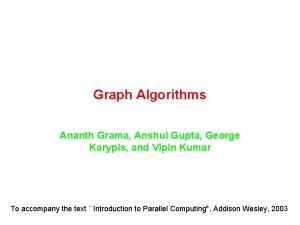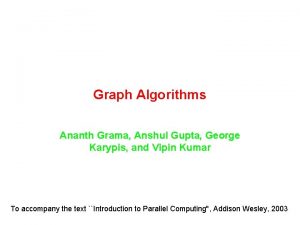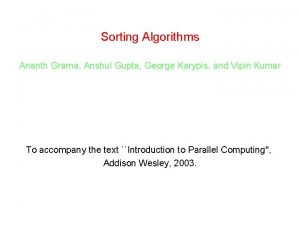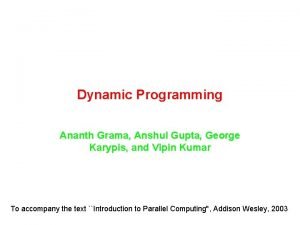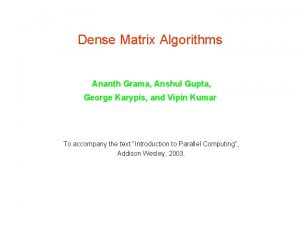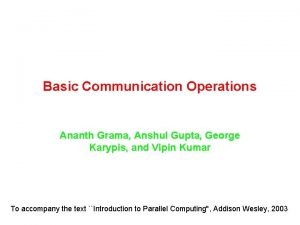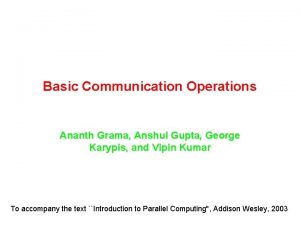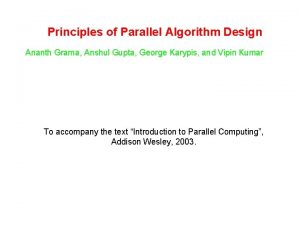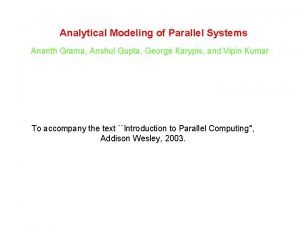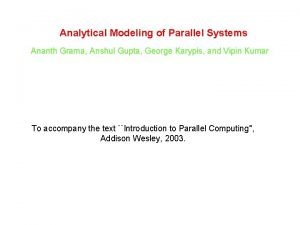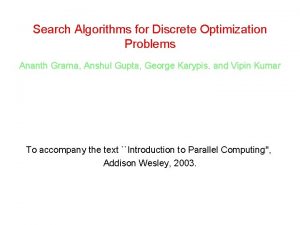Graph Algorithms Ananth Grama Anshul Gupta George Karypis
















































- Slides: 48

Graph Algorithms Ananth Grama, Anshul Gupta, George Karypis, and Vipin Kumar To accompany the text ``Introduction to Parallel Computing'', Addison Wesley, 2003

Topic Overview • All-Pairs Shortest Paths • Algorithms for Sparse Graphs

All-Pairs Shortest Paths • Given a weighted graph G(V, E, w), the all-pairs shortest paths problem is to find the shortest paths between all pairs of vertices vi, vj ∈ V. • A number of algorithms are known for solving this problem.

All-Pairs Shortest Paths: Matrix. Multiplication Based Algorithm • Consider the multiplication of the weighted adjacency matrix with itself - except, in this case, we replace the multiplication operation in matrix multiplication by addition, and the addition operation by minimization. • Notice that the product of weighted adjacency matrix with itself returns a matrix that contains shortest paths of length 2 between any pair of nodes. • It follows from this argument that An contains all shortest paths.

Matrix-Multiplication Based Algorithm

Matrix-Multiplication Based Algorithm • An is computed by doubling powers - i. e. , as A, A 2, A 4, A 8, and so on. • We need log n matrix multiplications, each taking time O(n 3). • The serial complexity of this procedure is O(n 3 log n). • This algorithm is not optimal, since the best known algorithms have complexity O(n 3).

Matrix-Multiplication Based Algorithm: Parallel Formulation • Each of the log n matrix multiplications can be performed in parallel. • We can use n 3/log n processors to compute each matrix product in time log n. • The entire process takes O(log 2 n) time.

Dijkstra's Algorithm • Execute n instances of the single-source shortest path problem, one for each of the n source vertices. • Complexity is O(n 3).

Dijkstra's Algorithm: Parallel Formulation • Two parallelization strategies - execute each of the n shortest path problems on a different processor (source partitioned), or use a parallel formulation of the shortest path problem to increase concurrency (source parallel).

Dijkstra's Algorithm: Source Partitioned Formulation • Use n processors, each processor Pi finds the shortest paths from vertex vi to all other vertices by executing Dijkstra's sequential single-source shortest paths algorithm. • It requires no interprocess communication (provided that the adjacency matrix is replicated at all processes). • The parallel run time of this formulation is: Θ(n 2). • While the algorithm is cost optimal, it can only use n processors. Therefore, the isoefficiency due to concurrency is p 3.

Dijkstra's Algorithm: Source Parallel Formulation • In this case, each of the shortest path problems is further executed in parallel. We can therefore use up to n 2 processors. • Given p processors (p > n), each single source shortest path problem is executed by p/n processors. • Using previous results, this takes time: • For cost optimality, we have p = O(n 2/log n) and the isoefficiency is Θ((p log p)1. 5).

Floyd's Algorithm • For any pair of vertices vi, vj ∈ V, consider all paths from vi to vj whose intermediate vertices belong to the set {v 1, v 2, …, vk}. Let pi(, kj) (of weight di(, kj) be the minimumweight path among them. • If vertex vk is not in the shortest path from vi to vj, then pi(, kj) is the same as pi(, kj-1). • If f vk is in pi(, kj), then we can break pi(, kj) into two paths one from vi to vk and one from vk to vj. Each of these paths uses vertices from {v 1, v 2, …, vk-1}.

Floyd's Algorithm From our observations, the following recurrence relation follows: This equation must be computed for each pair of nodes and for k = 1, n. The serial complexity is O(n 3).

Floyd's Algorithm Floyd's all-pairs shortest paths algorithm. This program computes the all-pairs shortest paths of the graph G = (V, E) with adjacency matrix A.

Floyd's Algorithm: Parallel Formulation Using 2 -D Block Mapping • Matrix D(k) is divided into p blocks of size (n / √p) x (n / √p). • Each processor updates its part of the matrix during each iteration. • To compute dl(, kk-1) processor Pi, j must get dl(, kk-1) and dk(, kr -1). • In general, during the kth iteration, each of the √p processes containing part of the kth row send it to the √p - 1 processes in the same column. • Similarly, each of the √p processes containing part of the kth column sends it to the √p - 1 processes in the same row.

Floyd's Algorithm: Parallel Formulation Using 2 -D Block Mapping (a) Matrix D(k) distributed by 2 -D block mapping into √p x √p subblocks, and (b) the subblock of D(k) assigned to process Pi, j.

Floyd's Algorithm: Parallel Formulation Using 2 -D Block Mapping (a) Communication patterns used in the 2 -D block mapping. When computing di(, kj), information must be sent to the highlighted process from two other processes along the same row and column. (b) The row and column of √p processes that contain the kth row and column send them along process columns and rows.

Floyd's Algorithm: Parallel Formulation Using 2 -D Block Mapping Floyd's parallel formulation using the 2 -D block mapping. P*, j denotes all the processes in the jth column, and Pi, * denotes all the processes in the ith row. The matrix D(0) is the adjacency matrix.

Floyd's Algorithm: Parallel Formulation Using 2 -D Block Mapping • During each iteration of the algorithm, the kth row and kth column of processors perform a one-to-all broadcast along their rows/columns. • The size of this broadcast is n/√p elements, taking time Θ((n log p)/ √p). • The synchronization step takes time Θ(log p). • The computation time is Θ(n 2/p). • The parallel run time of the 2 -D block mapping formulation of Floyd's algorithm is

Floyd's Algorithm: Parallel Formulation Using 2 -D Block Mapping • The above formulation can use O(n 2 / log 2 n) processors cost-optimally. • The isoefficiency of this formulation is Θ(p 1. 5 log 3 p). • This algorithm can be further improved by relaxing the strict synchronization after each iteration.

Floyd's Algorithm: Speeding Things Up by Pipelining • The synchronization step in parallel Floyd's algorithm can be removed without affecting the correctness of the algorithm. • A process starts working on the kth iteration as soon as it has computed the (k-1)th iteration and has the relevant parts of the D(k-1) matrix.

Floyd's Algorithm: Speeding Things Up by Pipelining Communication protocol followed in the pipelined 2 -D block mapping formulation of Floyd's algorithm. Assume that process 4 at time t has just computed a segment of the kth column of the D(k-1) matrix. It sends the segment to processes 3 and 5. These processes receive the segment at time t + 1 (where the time unit is the time it takes for a matrix segment to travel over the communication link between adjacent processes). Similarly, processes farther away from process 4 receive the segment later. Process 1 (at the boundary) does not forward the segment after receiving it.

Floyd's Algorithm: Speeding Things Up by Pipelining • In each step, n/√p elements of the first row are sent from process Pi, j to Pi+1, j. • Similarly, elements of the first column are sent from process Pi, j to process Pi, j+1. • Each such step takes time Θ(n/√p). • After Θ(√p) steps, process P√p , √p gets the relevant elements of the first row and first column in time Θ(n). • The values of successive rows and columns follow after time Θ(n 2/p) in a pipelined mode. • Process P√p , √p finishes its share of the shortest path computation in time Θ(n 3/p) + Θ(n). • When process P√p , √p has finished the (n-1)th iteration, it sends the relevant values of the nth row and column to the other processes.

Floyd's Algorithm: Speeding Things Up by Pipelining • The overall parallel run time of this formulation is • The pipelined formulation of Floyd's algorithm uses up to O(n 2) processes efficiently. • The corresponding isoefficiency is Θ(p 1. 5).

All-pairs Shortest Path: Comparison • The performance and scalability of the all-pairs shortest paths algorithms on various architectures with bisection bandwidth. Similar run times apply to all cube architectures, provided that processes are properly mapped to the underlying processors.

Transitive Closure • If G = (V, E) is a graph, then the transitive closure of G is defined as the graph G* = (V, E*), where E* = {(vi, vj) | there is a path from vi to vj in G} • The connectivity matrix of G is a matrix A* = (ai*, j) such that ai*, j = 1 if there is a path from vi to vj or i = j, and ai*, j = ∞ otherwise. • To compute A* we assign a weight of 1 to each edge of E and use any of the all-pairs shortest paths algorithms on this weighted graph.

Connected Components • The connected components of an undirected graph are the equivalence classes of vertices under the ``is reachable from'' relation. A graph with three connected components: {1, 2, 3, 4}, {5, 6, 7}, and {8, 9}.

Connected Components: Depth-First Search Based Algorithm • Perform DFS on the graph to get a forest - eac tree in the forest corresponds to a separate connected component. Part (b) is a depth-first forest obtained from depth-first traversal of the graph in part (a). Each of these trees is a connected component of the graph in part (a).

Connected Components: Parallel Formulation • Partition the graph across processors and run independent connected component algorithms on each processor. At this point, we have p spanning forests. • In the second step, spanning forests are merged pairwise until only one spanning forest remains.

Connected Components: Parallel Formulation Computing connected components in parallel. The adjacency matrix of the graph G in (a) is partitioned into two parts (b). Each process gets a subgraph of G ((c) and (e)). Each process then computes the spanning forest of the subgraph ((d) and (f)). Finally, the two spanning trees are merged to form the solution.

Connected Components: Parallel Formulation • To merge pairs of spanning forests efficiently, the algorithm uses disjoint sets of edges. • We define the following operations on the disjoint sets: • find(x) – returns a pointer to the representative element of the set containing x. Each set has its own unique representative. • union(x, y) – unites the sets containing the elements x and y. The two sets are assumed to be disjoint prior to the operation.

Connected Components: Parallel Formulation • For merging forest A into forest B, for each edge (u, v) of A, a find operation is performed to determine if the vertices are in the same tree of B. • If not, then the two trees (sets) of B containing u and v are united by a union operation. • Otherwise, no union operation is necessary. • Hence, merging A and B requires at most 2(n-1) find operations and (n-1) union operations.

Connected Components: Parallel 1 -D Block Mapping • The n x n adjacency matrix is partitioned into p blocks. • Each processor can compute its local spanning forest in time Θ(n 2/p). • Merging is done by embedding a logical tree into the topology. There are log p merging stages, and each takes time Θ(n). Thus, the cost due to merging is Θ(n log p). • During each merging stage, spanning forests are sent between nearest neighbors. Recall that Θ(n) edges of the spanning forest are transmitted.

Connected Components: Parallel 1 -D Block Mapping • The parallel run time of the connected-component algorithm is • For a cost-optimal formulation p = O(n / log n). The corresponding isoefficiency is Θ(p 2 log 2 p).

Algorithms for Sparse Graphs • A graph G = (V, E) is sparse if |E| is much smaller than |V|2. Examples of sparse graphs: (a) a linear graph, in which each vertex has two incident edges; (b) a grid graph, in which each vertex has four incident vertices; and (c) a random sparse graph.

Algorithms for Sparse Graphs • Dense algorithms can be improved significantly if we make use of the sparseness. For example, the run time of Prim's minimum spanning tree algorithm can be reduced from Θ(n 2) to Θ(|E| log n). • Sparse algorithms use adjacency list instead of an adjacency matrix. • Partitioning adjacency lists is more difficult for sparse graphs - do we balance number of vertices or edges? • Parallel algorithms typically make use of graph structure or degree information for performance.

Algorithms for Sparse Graphs A street map (a) can be represented by a graph (b). In the graph shown in (b), each street intersection is a vertex and each edge is a street segment. The vertices of (b) are the intersections of (a) marked by dots.

Finding a Maximal Independent Set • A set of vertices I ⊂ V is called independent if no pair of vertices in I is connected via an edge in G. An independent set is called maximal if by including any other vertex not in I, the independence property is violated. Examples of independent and maximal independent sets.

Finding a Maximal Independent Set (MIS) • Simple algorithms start by MIS I to be empty, and assigning all vertices to a candidate set C. • Vertex v from C is moved into I and all vertices adjacent to v are removed from C. • This process is repeated until C is empty. • This process is inherently serial!

Finding a Maximal Independent Set (MIS) • Parallel MIS algorithms use randimization to gain concurrency (Luby's algorithm for graph coloring). • Initially, each node is in the candidate set C. Each node generates a (unique) random number and communicates it to its neighbors. • If a nodes number exceeds that of all its neighbors, it joins set I. All of its neighbors are removed from C. • This process continues until C is empty. • On average, this algorithm converges after O(log|V|) such steps.

Finding a Maximal Independent Set (MIS) The different augmentation steps of Luby's randomized maximal independent set algorithm. The numbers inside each vertex correspond to the random number assigned to the vertex.

Finding a Maximal Independent Set (MIS): Parallel Formulation • We use three arrays, each of length n - I, which stores nodes in MIS, C, which stores the candidate set, and R, the random numbers. • Partition C across p processors. Each processor generates the corresponding values in the R array, and from this, computes which candidate vertices can enter MIS. • The C array is updated by deleting all the neighbors of vertices that entered MIS. • The performance of this algorithm is dependent on the structure of the graph.

Single-Source Shortest Paths • Dijkstra's algorithm, modified to handle sparse graphs is called Johnson's algorithm. • The modification accounts for the fact that the minimization step in Dijkstra's algorithm needs to be performed only for those nodes adjacent to the previously selected nodes. • Johnson's algorithm uses a priority queue Q to store the value l[v] for each vertex v ∈ (V – VT).

Single-Source Shortest Paths: Johnson's Algorithm Johnson's sequential single-source shortest paths algorithm.

Single-Source Shortest Paths: Parallel Johnson's Algorithm • Maintaining strict order of Johnson's algorithm generally leads to a very restrictive class of parallel algorithms. • We need to allow exploration of multiple nodes concurrently. This is done by simultaneously extracting p nodes from the priority queue, updating the neighbors' cost, and augmenting the shortest path. • If an error is made, it can be discovered (as a shorter path) and the node can be reinserted with this shorter path.

Single-Source Shortest Paths: Parallel Johnson's Algorithm An example of the modified Johnson's algorithm for processing unsafe vertices concurrently.

Single-Source Shortest Paths: Parallel Johnson's Algorithm • Even if we can extract and process multiple nodes from the queue, the queue itself is a major bottleneck. • For this reason, we use multiple queues, one for each processor. Each processor builds its priority queue only using its own vertices. • When process Pi extracts the vertex u ∈ Vi, it sends a message to processes that store vertices adjacent to u. • Process Pj, upon receiving this message, sets the value of l[v] stored in its priority queue to min{l[v], l[u] + w(u, v)}.

Single-Source Shortest Paths: Parallel Johnson's Algorithm • If a shorter path has been discovered to node v, it is reinserted back into the local priority queue. • The algorithm terminates only when all the queues become empty. • A number of node paritioning schemes can be used to exploit graph structure for performance.
 Ananth grama
Ananth grama Motivating parallelism
Motivating parallelism Introduction to parallel computing ananth grama ppt
Introduction to parallel computing ananth grama ppt Introduction to parallel computing ananth grama
Introduction to parallel computing ananth grama Dr. anshul gandhi
Dr. anshul gandhi Adressen data2business
Adressen data2business Ananth kadekodi
Ananth kadekodi Ananth shenoy
Ananth shenoy Confuse
Confuse Elementary graph algorithms
Elementary graph algorithms When graphs are life
When graphs are life W graph
W graph Undirected graph algorithms
Undirected graph algorithms Differences between george washington and king george iii
Differences between george washington and king george iii George washington and thomas jefferson venn diagram
George washington and thomas jefferson venn diagram Imagens de pronomes pessoais
Imagens de pronomes pessoais Steliana grama
Steliana grama Farbenie podla grama
Farbenie podla grama O gafanhoto é verde porque vive na grama lamarck
O gafanhoto é verde porque vive na grama lamarck Eraviperoor grama panchayat
Eraviperoor grama panchayat Polizaharide
Polizaharide Feromagnētiķi
Feromagnētiķi Grama no problem
Grama no problem Sufijo grama
Sufijo grama Simbol fluor
Simbol fluor Line graph graph theory
Line graph graph theory Wait-for graph
Wait-for graph Grraacceess
Grraacceess Shambhu gupta & co
Shambhu gupta & co Bela gupta
Bela gupta Quadracopters
Quadracopters Shankar gupta
Shankar gupta Anjum gupta ucsd
Anjum gupta ucsd Dinesh gupta icgeb
Dinesh gupta icgeb Persian
Persian Hyperkalemia
Hyperkalemia Dr sonal gupta
Dr sonal gupta Dr vijayant gupta
Dr vijayant gupta Navin gupta md
Navin gupta md Kerititis
Kerititis Rupayan gupta
Rupayan gupta Dda circle drawing algorithm
Dda circle drawing algorithm Gupta empire philosophy
Gupta empire philosophy Amritdhara pharmacy v. satya deo gupta
Amritdhara pharmacy v. satya deo gupta Aseem gupta adq
Aseem gupta adq Kavita gupta md
Kavita gupta md Fag bearings india limited
Fag bearings india limited Dr pulin gupta
Dr pulin gupta Vclab odu
Vclab odu
